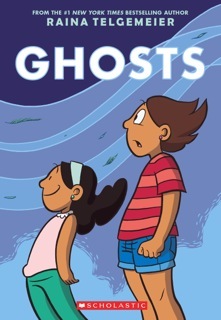Writing Connections with Raina Telgemeier
by Mary Quattlebaum
 Is the classroom or your personal journaling experience starting to pall? One way to spice up the journal-keeping process is to add visuals. That’s how Raina Telgemeier got her start as a graphic novelist when she was 10 years old. In a recent interview in the KidsPost section of the Washington Post, Raina talks about her newest graphic novel
Ghosts
and how she began keeping a comics diary when she was a kid.
Is the classroom or your personal journaling experience starting to pall? One way to spice up the journal-keeping process is to add visuals. That’s how Raina Telgemeier got her start as a graphic novelist when she was 10 years old. In a recent interview in the KidsPost section of the Washington Post, Raina talks about her newest graphic novel
Ghosts
and how she began keeping a comics diary when she was a kid.
Below are writing lessons for the classroom or for individual writers ages 8 and up. Telgemeir’s website also has teacher’s guides.
WRITING/DRAWING YOUR LIFE: Classroom Discussion, Part 1: You might start by showing kids various examples of graphic novels (Telgemeier’s Smile, Sisters and Ghosts; Jennifer Holm’s Babymouse series, Gene Yang’s Secret Coders series). Though most tell a fictional story, Smile and Sisters chronicle events in Telgemeier’s life.

Classroom Writing: Instead of the usual journaling-in-words-only that is done as part of the classroom writing experience, encourage students to do what Telgemeir did as a kid. In a “comics diary,” she recorded her days in comic-strip form. This loose, sketchy process helps kids to avoid getting hung up on creating “realistic” drawings and instead encourages them to focus on what’s key to the day/emotion/scene in very stylized drawings. Students might do just one panel with dialogue balloons that captures an experience or several linked ones.
You might also have them bring photos from home or have some magazines on hand so they might cut and paste in backgrounds, relevant images, etc.
Examples of Prompts (these also work for traditional journal entries): What made me scared today? Angry? Excited? Annoyed? Happy? Before writing, have students close their eyes and focus on their day and call a particular emotion/event to mind.
Classroom Discussion, Part 2: After about a week of keeping a comics journal, ask students which they preferred, comics journal or the more traditional writing journal. Or perhaps a combination. What did they like/dislike about all three? What did they enjoy/learn from the comics diary experience? Did doing their own comics diaries change the way they looked at/read graphic novels?
www.maryquattlebaum.com
 Is the classroom or your personal journaling experience starting to pall? One way to spice up the journal-keeping process is to add visuals. That’s how Raina Telgemeier got her start as a graphic novelist when she was 10 years old. In a recent interview in the KidsPost section of the Washington Post, Raina talks about her newest graphic novel
Ghosts
and how she began keeping a comics diary when she was a kid.
Is the classroom or your personal journaling experience starting to pall? One way to spice up the journal-keeping process is to add visuals. That’s how Raina Telgemeier got her start as a graphic novelist when she was 10 years old. In a recent interview in the KidsPost section of the Washington Post, Raina talks about her newest graphic novel
Ghosts
and how she began keeping a comics diary when she was a kid.Below are writing lessons for the classroom or for individual writers ages 8 and up. Telgemeir’s website also has teacher’s guides.
WRITING/DRAWING YOUR LIFE: Classroom Discussion, Part 1: You might start by showing kids various examples of graphic novels (Telgemeier’s Smile, Sisters and Ghosts; Jennifer Holm’s Babymouse series, Gene Yang’s Secret Coders series). Though most tell a fictional story, Smile and Sisters chronicle events in Telgemeier’s life.

Classroom Writing: Instead of the usual journaling-in-words-only that is done as part of the classroom writing experience, encourage students to do what Telgemeir did as a kid. In a “comics diary,” she recorded her days in comic-strip form. This loose, sketchy process helps kids to avoid getting hung up on creating “realistic” drawings and instead encourages them to focus on what’s key to the day/emotion/scene in very stylized drawings. Students might do just one panel with dialogue balloons that captures an experience or several linked ones.
You might also have them bring photos from home or have some magazines on hand so they might cut and paste in backgrounds, relevant images, etc.
Examples of Prompts (these also work for traditional journal entries): What made me scared today? Angry? Excited? Annoyed? Happy? Before writing, have students close their eyes and focus on their day and call a particular emotion/event to mind.
Classroom Discussion, Part 2: After about a week of keeping a comics journal, ask students which they preferred, comics journal or the more traditional writing journal. Or perhaps a combination. What did they like/dislike about all three? What did they enjoy/learn from the comics diary experience? Did doing their own comics diaries change the way they looked at/read graphic novels?
www.maryquattlebaum.com
Published on January 23, 2017 14:00
No comments have been added yet.
Mary Quattlebaum's Blog
- Mary Quattlebaum's profile
- 22 followers
Mary Quattlebaum isn't a Goodreads Author
(yet),
but they
do have a blog,
so here are some recent posts imported from
their feed.



